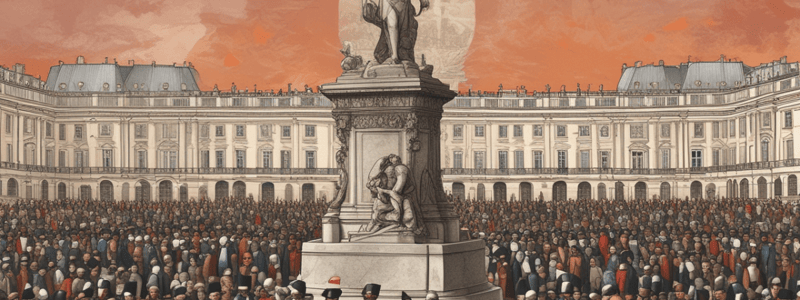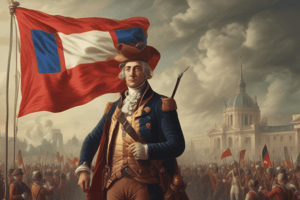Podcast
Questions and Answers
A type of government where all power lies in one person, often the _______________.
A type of government where all power lies in one person, often the _______________.
king or queen
The rate of increase in prices over a given period of time is called _______________.
The rate of increase in prices over a given period of time is called _______________.
inflation
A _______________ is a middle class person.
A _______________ is a middle class person.
bourgeoisie
The Tennis Court Oath started on _______________ 20, 1789 at the palace of Versailles.
The Tennis Court Oath started on _______________ 20, 1789 at the palace of Versailles.
The process of beginning to use machines, technology to do work is called _______________.
The process of beginning to use machines, technology to do work is called _______________.
The first industrial revolution in Britain included the _______________ of the Spinning Jenny.
The first industrial revolution in Britain included the _______________ of the Spinning Jenny.
The intent to destroy a national or religious group is called _______________.
The intent to destroy a national or religious group is called _______________.
The practice of growing crops or raising animals is called _______________.
The practice of growing crops or raising animals is called _______________.
Loyalty and attachment to a country is called _______________.
Loyalty and attachment to a country is called _______________.
The process of being similar to others is called _______________.
The process of being similar to others is called _______________.
The Indian Act classified Indians into two categories: ______ Indians and ______ Indians.
The Indian Act classified Indians into two categories: ______ Indians and ______ Indians.
The main ______ of the Indian Act was to control and assimilate Indigenous peoples.
The main ______ of the Indian Act was to control and assimilate Indigenous peoples.
The Indian Act was a ______ piece of legislation imposed on Aboriginals by the government.
The Indian Act was a ______ piece of legislation imposed on Aboriginals by the government.
The 1969 White Paper aimed to ______ Indian status and treaties.
The 1969 White Paper aimed to ______ Indian status and treaties.
Residential schools were established to achieve the ______ of Indigenous peoples into a settler society.
Residential schools were established to achieve the ______ of Indigenous peoples into a settler society.
The Indian Act used residential schools to ______ Indigenous culture and community.
The Indian Act used residential schools to ______ Indigenous culture and community.
Residential schools were marred by ______, including physical, emotional, and sexual abuse of Indigenous children.
Residential schools were marred by ______, including physical, emotional, and sexual abuse of Indigenous children.
Indigenous children in residential schools were prohibited from ______ their own language.
Indigenous children in residential schools were prohibited from ______ their own language.
Residential schools prevented Indigenous children from ______ their cultural traditions or activities.
Residential schools prevented Indigenous children from ______ their cultural traditions or activities.
Indigenous children in residential schools were ______ from their homes and unable to communicate with their families.
Indigenous children in residential schools were ______ from their homes and unable to communicate with their families.
A social and economic system where the means of production are owned by the state is called capitalism.
A social and economic system where the means of production are owned by the state is called capitalism.
The Tennis Court Oath was an event that took place on June 21, 1789.
The Tennis Court Oath was an event that took place on June 21, 1789.
The practice of growing crops or raising animals is called urbanization.
The practice of growing crops or raising animals is called urbanization.
The Spinning Jenny was a machine used for spinning wool or silk.
The Spinning Jenny was a machine used for spinning wool or silk.
The first industrial revolution in Britain included the invention of the Steam Engine in the late 17th century.
The first industrial revolution in Britain included the invention of the Steam Engine in the late 17th century.
Nationalism refers to loyalty and attachment to a particular region.
Nationalism refers to loyalty and attachment to a particular region.
Paternalism refers to the process of being similar to others.
Paternalism refers to the process of being similar to others.
The Indian Act was a colonial piece of legislation imposed on Aboriginals by the government.
The Indian Act was a colonial piece of legislation imposed on Aboriginals by the government.
The main goal of the Indian Act was to recognize and respect Indigenous peoples' autonomy.
The main goal of the Indian Act was to recognize and respect Indigenous peoples' autonomy.
Residential schools were established to promote Indigenous culture and community.
Residential schools were established to promote Indigenous culture and community.
The Indian Act was a treaty negotiated with Aboriginal peoples.
The Indian Act was a treaty negotiated with Aboriginal peoples.
The main goal of the Indian Act was to empower Indigenous peoples.
The main goal of the Indian Act was to empower Indigenous peoples.
The 1969 White Paper aimed to strengthen Indian status and treaties.
The 1969 White Paper aimed to strengthen Indian status and treaties.
Residential schools were established to promote Indigenous cultural traditions.
Residential schools were established to promote Indigenous cultural traditions.
The Indian Act treated Aboriginal people as equals.
The Indian Act treated Aboriginal people as equals.
Residential schools were free from trauma and abuse.
Residential schools were free from trauma and abuse.
Indigenous children in residential schools were allowed to speak their own language.
Indigenous children in residential schools were allowed to speak their own language.
Residential schools encouraged Indigenous cultural traditions and activities.
Residential schools encouraged Indigenous cultural traditions and activities.
Indigenous children in residential schools could communicate freely with their families.
Indigenous children in residential schools could communicate freely with their families.
The Indian Act was a voluntary agreement between the government and Aboriginal peoples.
The Indian Act was a voluntary agreement between the government and Aboriginal peoples.
Flashcards are hidden until you start studying
Study Notes
Systems of Government and Society
- Absolute Monarchy: a government where all power lies in one person, often the king or queen.
- Feudalism: a medieval model of government before the birth of the modern nation-state.
Important Events and Groups
- Tennis Court Oath: an oath taken on June 20, 1789, at the Palace of Versailles, marking the beginning of the French Revolution.
- National Assembly: a group that played a key role in the French Revolution.
- Declaration of the Rights of Man and Citizen: a document adopted in 1789, stating the fundamental principles of the French Revolution.
- Reign of Terror: a period of violence during the French Revolution, marked by the establishment of the Committee of Public Safety.
Economic Systems and Concepts
- Capitalism: an economic system.
- Socialism: a way to organize a society.
- Mechanization: the process of beginning to use machines and technology to do work.
- Urbanization: the increase in population of people living in towns and cities.
- Agriculture: the practice of growing crops or raising animals.
- Inflation: the rate of increase in prices over a given period of time.
- Deficit: a deficiency in amount or price.
Industrial Revolution
- First Industrial Revolution in Britain: started in the late 18th and 19th centuries, marked by mechanization, including the invention of the Spinning Jenny.
- Spinning Jenny: a machine used for spinning wool or cotton.
- Steam Engine: a machine using steam power to perform mechanical work through heat.
- Changes to Transportation: the use of steam engines led to the development of locomotives and steam boats, revolutionizing transportation.
Social and Political Concepts
- Assimilate: the process of becoming similar to others.
- Paternalism: making all the decisions for the people you govern.
- Colonialism: control by one power over another.
- Cultural Genocide: the intent to destroy a national or religious group.
- Reserves: held back for future use.
The Indian Act
- Classifications: Non-Status Indians and Status Indians.
- Goals: control and assimilation.
- The Indian Act is paternalistic, treating Aboriginal people like children that need parents to look after them.
- The Indian Act is not a treaty and was imposed on Aboriginals by the government.
Residential Schools
- Established by the Canadian government to assimilate Indigenous peoples into a settler society.
- Trauma and Abuse: widespread physical, emotional, and sexual abuse of Indigenous children.
- Control over education, prohibiting Indigenous languages and cultural practices.
- Children were taken away from their homes, unable to communicate with their families.
Systems of Government and Society
- Absolute Monarchy: a government where all power lies in one person, often the king or queen.
- Feudalism: a medieval model of government before the birth of the modern nation-state.
Important Events and Groups
- Tennis Court Oath: an oath taken on June 20, 1789, at the Palace of Versailles, marking the beginning of the French Revolution.
- National Assembly: a group that played a key role in the French Revolution.
- Declaration of the Rights of Man and Citizen: a document adopted in 1789, stating the fundamental principles of the French Revolution.
- Reign of Terror: a period of violence during the French Revolution, marked by the establishment of the Committee of Public Safety.
Economic Systems and Concepts
- Capitalism: an economic system.
- Socialism: a way to organize a society.
- Mechanization: the process of beginning to use machines and technology to do work.
- Urbanization: the increase in population of people living in towns and cities.
- Agriculture: the practice of growing crops or raising animals.
- Inflation: the rate of increase in prices over a given period of time.
- Deficit: a deficiency in amount or price.
Industrial Revolution
- First Industrial Revolution in Britain: started in the late 18th and 19th centuries, marked by mechanization, including the invention of the Spinning Jenny.
- Spinning Jenny: a machine used for spinning wool or cotton.
- Steam Engine: a machine using steam power to perform mechanical work through heat.
- Changes to Transportation: the use of steam engines led to the development of locomotives and steam boats, revolutionizing transportation.
Social and Political Concepts
- Assimilate: the process of becoming similar to others.
- Paternalism: making all the decisions for the people you govern.
- Colonialism: control by one power over another.
- Cultural Genocide: the intent to destroy a national or religious group.
- Reserves: held back for future use.
The Indian Act
- Classifications: Non-Status Indians and Status Indians.
- Goals: control and assimilation.
- The Indian Act is paternalistic, treating Aboriginal people like children that need parents to look after them.
- The Indian Act is not a treaty and was imposed on Aboriginals by the government.
Residential Schools
- Established by the Canadian government to assimilate Indigenous peoples into a settler society.
- Trauma and Abuse: widespread physical, emotional, and sexual abuse of Indigenous children.
- Control over education, prohibiting Indigenous languages and cultural practices.
- Children were taken away from their homes, unable to communicate with their families.
Studying That Suits You
Use AI to generate personalized quizzes and flashcards to suit your learning preferences.





